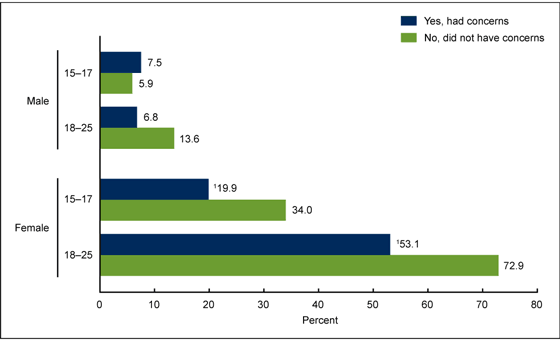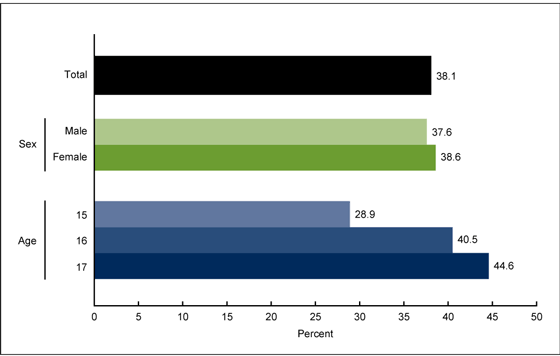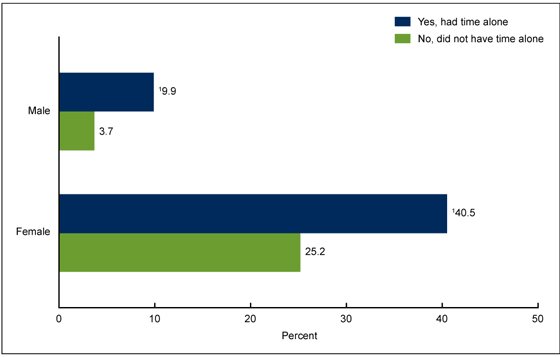Confidentiality Concerns and Sexual and Reproductive Health Care Among Adolescents and Young Adults Aged 15–25
On This Page
- Key findings
- What percentage of persons aged 15–25 would not seek sexual or reproductive health care because of concerns that their parents might find out about it?
- Were persons aged 15–25 less likely to receive sexual or reproductive health services in the past year if they had concerns that their parents might find out about it?
- What percentage of teenagers aged 15–17 spent some time alone in the past year during a visit with a doctor or other health care provider without a parent, relative, or guardian in the room?
- Did receipt of sexual or reproductive health services in the past year vary by whether teenagers aged 15–17 spent some time alone in the past year during a visit with a doctor or health care provider?
- Summary
- Definitions
- Data source and methods
- About the authors
- References
- Suggested citation
NCHS Data Brief No. 266, December 2016
PDF Version (395 KB)
Casey E. Copen, M.P.H., Ph.D., Patricia J. Dittus, Ph.D., and Jami S. Leichliter, Ph.D.
Key findings
Data from the National Survey of Family Growth
- About 7% of persons aged 15–25 would not seek sexual or reproductive health care because of concerns that their parents might find out about it.
- For females aged 15–17 and 18–25, those who had confidentiality concerns were less likely to receive sexual and reproductive health services in the past year compared with those without these concerns.
- Less than one-half of teenagers aged 15–17 (38.1%) spent some time alone in the past year during a visit with a doctor or other health care provider without a parent, relative, or guardian in the room.
- Teenagers aged 15–17 who spent some time alone during a visit with a health care provider were more likely to have received sexual or reproductive health services in the past year compared with those who had not.
Confidentiality concerns can impact adolescent and young adults’ access to sexual and reproductive health services (1–4). Young people who are covered by their parents’ private health insurance may be deterred from obtaining these services due to concerns that their parents might find out about it (2). Similarly, confidentiality concerns may arise because youth seeking such services may not have time alone during a visit with a health care provider (4). This report describes two measures related to confidentiality concerns and sexual and reproductive health care.
Keywords: youth, health services, National Survey of Family Growth
What percentage of persons aged 15–25 would not seek sexual or reproductive health care because of concerns that their parents might find out about it?
- Among those aged 15–25, 7.4% would not seek sexual or reproductive health care because of concerns that their parents might find out about it (Figure 1).
- The percentages of females (7.4%) and males (7.5%) aged 15–25 who would not seek sexual or reproductive health care because of concerns that their parents might find out about it were similar.
- Among those aged 15–25, older age was associated with a decrease in the percentage of persons who had confidentiality concerns regarding sexual or reproductive health care. A total of 17.9% of those aged 15–17, 6.6% of those aged 18–19, 3.9% of those aged 20–22, and 1.8% of those aged 23–25 had confidentiality concerns.
Figure 1. Percentage of persons aged 15–25 who would not seek sexual or reproductive health care because of concerns that their parents might find out about it, by sex and age: United States, 2013–2015
NOTES: Significant linear trend by age group (p < 0.05). For those aged 18–25, this question was only asked if they were on their parents’ private health insurance plan. Access data table for Figure 1.
SOURCE: NCHS, National Survey of Family Growth, 2013–2015.
Were persons aged 15–25 less likely to receive sexual or reproductive health services in the past year if they had concerns that their parents might find out about it?
- Females aged 15–17 and 18–25 who had concerns about seeking sexual or reproductive health care because their parents might find about it were less likely than those without these concerns to receive such services in the past year (19.9% compared with 34.0% for females aged 15–17 and 53.1% compared with 72.9% for females aged 18–25) (Figure 2).
- Regardless of age, there were no differences in the percentages of males aged 15–25 who received sexual or reproductive health services according to whether they had concerns that their parents might found out about it.
Figure 2. Percentage of persons aged 15–25 who received any sexual or reproductive health services in the past year, by age group and whether or not they had concerns that their parents might find out about it: United States, 2013–2015
1Significantly different from “no” category (p < 0.05).
NOTES: For those aged 18–25, this question was only asked if they were on their parents’ private health insurance plan. Regardless of whether they had confidentiality concerns, females aged 15–25 were more likely to receive any sexual or reproductive health service in the past year compared with males aged 15–25 (p < 0.05). Any sexual or reproductive health service for females includes receiving a method of birth control or prescription for a method, a checkup or medical test related to using a birth control method, counseling or information about birth control, a Pap test, a pelvic examination, or a test for a sexually transmitted disease. Any sexual or reproductive health service for males includes testing for information or advice about using condoms, information or advice about their partner using female methods of birth control, or a test for a sexually transmitted disease. Access data table for Figure 2.
SOURCE: NCHS, National Survey of Family Growth, 2013–2015.
What percentage of teenagers aged 15–17 spent some time alone in the past year during a visit with a doctor or other health care provider without a parent, relative, or guardian in the room?
- In 2013–2015, 38.1% of teenagers aged 15–17 spent some alone in the past year during a visit with a doctor or other health care provider without a parent, relative, or guardian in the room (Figure 3).
- The percentages of females (38.6%) and males (37.6%) aged 15–17 who spent some time alone in the past year during a visit with a doctor or other health care provider in the past year were similar.
- Among teenagers aged 15–17, older age was associated with an increase in the percentage of teenagers who spent some time alone in the past year during a visit with a doctor or other health care provider. A total of 28.9% of those aged 15, 40.5% of those aged 16, and 44.6% of those aged 17 spent some time alone with a doctor or other health care provider in the past year.
Figure 3. Percentage of teenagers aged 15–17 who spent any time alone in the past year with a doctor or other health care provider, by sex and age: United States, 2013–2015
NOTES: Significant linear trend by age (p < 0.05). For this analysis, those who reported they did not have a health care visit in the past year were grouped with those who said “no.” Access data table for Figure 3.
SOURCE: NCHS, National Survey of Family Growth, 2013–2015.
Did receipt of sexual or reproductive health services in the past year vary by whether teenagers aged 15–17 spent some time alone in the past year during a visit with a doctor or health care provider?
- Higher percentages of females aged 15–17 who spent some time alone with a doctor or other health care provider in the past year without a parent, relative, or guardian in the room received sexual or reproductive health services in the past year (40.5%) compared with females aged 15–17 who had not (25.2%) (Figure 4).
- Higher percentages of males aged 15–17 who spent some time alone with a doctor or other health care provider in the past year without a parent, relative, or guardian in the room received sexual or reproductive health services in the past year (9.9%) compared with males aged 15–17 who had not (3.7%).
Figure 4. Percentage of teenagers aged 15–17 who received any sexual or reproductive health services in the past year, by whether they spent any time alone with a doctor or other health care provider in the past year: United States, 2013–2015
1Significantly different from “no” category (p < 0.05).
NOTES: For this analysis, those who reported they did not have a health care visit in the past year were grouped with those who said “no.” Females aged 15–25 were more likely to receive any sexual or reproductive health service in the past year compared with males aged 15–25 (p < 0.05). Receipt of sexual or reproductive health services in the past year, as shown in this report, may not have occurred as a direct result of time spent alone with a health provider. Any sexual or reproductive health service for females includes receiving a method of birth control or prescription for a method, a checkup or medical test related to using a birth control method, counseling or information about birth control, a Pap test, a pelvic examination, or a test for a sexually transmitted disease. Any sexual or reproductive health service for males includes testing for information or advice about using condoms, information or advice about their partner using female methods of birth control, or a test for a sexually transmitted disease. Access data table for Figure 4.
SOURCE: NCHS, National Survey of Family Growth, 2013–2015.
Summary
The analysis in this report showed that 7.4% of persons aged 15–25 would not seek sexual or reproductive health care because of concerns that their parents might find out about it. Females aged 15–25 were less likely to have received these services in the past year if they had concerns that their parents might find out about it compared with those without these concerns. In contrast, males aged 15–25 had similar percentages for those who received such services in the past year whether or not they had confidentiality concerns. Less than one-half of teenagers aged 15–17 spent some time alone in the past year during a visit with a doctor or other health care provider. Additionally, teenagers aged 15–17 who spent some time alone in the past year during a visit with a doctor or other health care provider were more likely to receive sexual or reproductive health services in the past year than those who had not.
In 2012, 58% of young adults aged 19–25 had private health insurance, and the majority obtained this coverage through their parents’ employment (5). Given that private health insurance coverage among young adults is primarily through a parent’s private health insurance plan (5), confidentiality of health care may be a concern for young people, particularly those seeking access to sensitive services, such as sexual and reproductive health care (2). The findings in this report are consistent with other studies showing that concerns over confidentiality may impact health care receipt among persons aged 15–25 in the United States (1–4).
Definitions
Any sexual or reproductive health service for females: Based on a “yes” response to at least one of six separate questions about types of services used that were asked of all female respondents, regardless of whether they had a health care visit in the past year. For this analysis, the sexual and reproductive health services included were 1) “a method of birth control or a prescription for a method,” 2) “a check-up or medical test related to using a birth control method,” 3) “counseling or information about birth control,” 4) “a Pap test—where a doctor or nurse put an instrument in the vagina and took a sample to check for abnormal cells that could turn into cervical cancer,” 5) “a pelvic examination—where a doctor or nurse puts one hand in the vagina and the other on the abdomen,” and 6) “testing for a sexually transmitted disease.”
Any sexual or reproductive health service for males: Based on responses to an “enter all that apply” question that asked male respondents who had a health care visit in the past year what specific services they had received. For this analysis, the sexual or reproductive health services included were “information or advice about using condoms,” “information or advice about your partner using female methods of birth control,” and “testing for a sexually transmitted disease.” Those who reported they did not have a health care visit in the past year were grouped with those who said “no.”
Not seeking sexual or reproductive health care: Based on the question, “Would you ever not go for sexual or reproductive health care because your parents might find out?” This question was asked of all females and males aged 15–17 and those aged 18–25 who were covered on their parents’ private health insurance. For this analysis, those aged 18–25 who did not have private health insurance, or who had private insurance but were not covered by their parents’ health insurance, were grouped with those who said “no.” The variable used for this analysis was CONFCONC.
Time alone with a doctor or other health care provider: Based on the question, “The last time you had a health care visit in the past 12 months, did a doctor or other health provider spend any time alone with you without a parent, relative, or guardian in the room?” This question was asked of females and males aged 15–17. For this analysis, those who reported they did not have a health care visit in the past year were grouped with those who said “no.” The variable used for this analysis was TIMALON.
Data source and methods
Data from the 2013–2015 National Survey of Family Growth (NSFG) were used for these analyses. NSFG is a nationally representative survey of the U.S. household population, with face-to-face interviews conducted with females and males aged 15–44. More information on NSFG is available from: https://www.cdc.gov/nchs/nsfg.htm. For this report, the analysis was limited to those aged 15–25. The variables related to confidentiality concerns for persons aged 15–25 (CONFCONC and TIMALON) were collected using audio computer-assisted self-interviewing (ACASI). In ACASI, the respondent listens to the questions through headphones, reads them on the screen, or both, and enters the responses directly into the computer without telling them to an interviewer. Statistics for this report, including sampling errors, were produced using the survey analysis procedures in SAS software version 9.4. Differences between groups were evaluated using a t statistic at the p less than or equal to 0.05 significance level. A weighted least-squares regression method was used to test the significance of trends that involved more than two age groups. The difference between any two estimates is mentioned in the text only if it is statistically significant. Terms such as “similar” or “no differences” indicate that the difference between estimates being compared are not statistically significant.
About the authors
Casey E. Copen is with the National Center for Health Statistics. Patricia J. Dittus and Jami S. Leichliter are with CDC’s National Center for HIV/AIDS, Viral Hepatitis, STD, and TB Prevention.
References
- Ford CA, Millstein SG, Halpern-Felsher BL, Irwin CE Jr. Influence of physician confidentiality assurances on adolescents’ willingness to disclose information and seek future health care. A randomized controlled trial. JAMA 278(12):1029–34. 1997.
- Klein JD, Wilson KM, McNulty M, Kapphahn C, Collins KS. Access to medical care for adolescents: Results from the 1997 Commonwealth Fund Survey of the Health of Adolescent Girls. J Adolesc Health 25(2):120–30. 1999.
- O’Sullivan LF, McKee MD, Rubin SE, Campos G. Primary care providers’ reports of time alone and the provision of sexual health services to urban adolescent patients: Results of a prospective card study. J Adolesc Health 47(1):110–2. 2010.
- Edman JC, Adams SH, Park MJ, Irwin CE Jr. Who gets confidential care? Disparities in a national sample of adolescents. J Adolesc Health 46(4):393–5. 2010.
- Kirzinger WK, Cohen RA, Gindi RM. Trends in insurance coverage and source of private coverage among young adults aged 19–25: United States, 2008–2012. NCHS data brief, no 137. Hyattsville, MD: National Center for Health Statistics. 2013.
Suggested citation
Copen CE, Dittus PJ, Leichliter JS. Confidentiality concerns and sexual and reproductive health care among adolescents and young adults aged 15–25. NCHS data brief, no 266. Hyattsville, MD: National Center for Health Statistics. 2016.
Copyright information
All material appearing in this report is in the public domain and may be reproduced or copied without permission; citation as to source, however, is appreciated.
National Center for Health Statistics
Charles J. Rothwell, M.S., M.B.A., Director
Jennifer H. Madans, Ph.D., Associate Director for Science
Division of Vital Statistics
Delton Atkinson, M.P.H., M.P.H., P.M.P., Director
Hanyu Ni, Ph.D., M.P.H., Associate Director for Science
- Page last reviewed: December 16, 2016
- Page last updated: December 16, 2016
- Content source:


 ShareCompartir
ShareCompartir



